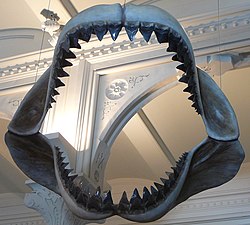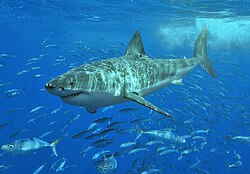Megalodon
Megalodon is an extinct species of shark and was the largest shark of all time, as far as we know. Its scientific name is Otodus megalodon (meaning "Big ear-shapped tooth"). It lived from the early Miocene to the Pliocene epochs, 23 to 3.6 million years ago (mya). It is a member of the family Otodontidae. When it was first described paleontologists thought it was the ancestor of the present-day great white shark (Carcharodon carcharias ), buy closer inspection distanced the 2 species.
| Megalodon | |
|---|---|

| |
| Model of the jaws of the megalodon at the American Museum of Natural History | |
| Scientific classification | |
| Kingdom: | |
| Subphylum: | |
| Class: | |
| Subclass: | |
| Order: | |
| Family: | |
| Genus: | |
| Species: | †O. megalodon
|
| Binomial name | |
| †Otodus megalodon Agassiz, 1835
| |
| Synonyms | |
| |

Megalodon had teeth, which are among the largest ever found, over 18 cm (7.1 in) long. Nicolaus Steno was the first to recognize the teeth as those of a giant shark. Paleontologists calculate that the shark was up to 20.3 m (67 ft) long with average length of 17 meters (56 feet). It weighed up to 48-103 metric tons.[1]
Classification
As is the case with most sharks, the classification of O. megalodon is under debate. The species was named by the Naturalist and French Louis Agassiz, he named the species Carcharodon megalodon. During this period, species within the same genus were named, such as Carcharodon productus and Carcharodon rectidens, which were synonymized as belonging to the same species a few decades later. For a long time, Megalodon was considered an extinct species of Great White Shark, popularly called the "Giant Great White Shark" or informally the "Monster Shark."
This changed with new studies in the early 20th century, when it began to be classified more closely within the genus Carcharocles and as part of the Otodontid evolutionary line. Nowadays, the species can be classified in different genera, in the genus Otodus, Procarcharodon, Megaselachus, or Carcharocles. This is because Megalodon belongs to a lineage of chronospecies, which have evolved over time.
Paleoecology
Fossil records of O. megalodon indicate that it occurred in deep to tropical latitudes.[2] Before the formation of the Isthmus of Panama, the seas were relatively warmer.[3] This would have made it possible for the species to live in all the oceans of the world.
O. megalodon lived in many marine environments (i.e. continental shelf waters,[4] coastal upwelling,[4] swampy coastal lagoons,[4] sandy littorals,[4] and offshore deep water environments),[5] and moved from place to place.[4] Adult O. megalodon were not abundant in shallow water environments,[4] and mostly lurked offshore. O. megalodon may have moved between coastal and oceanic waters, at different stages in its life.
Its prey
Megalodon hunted large and medium-sized whales, attacking the bony areas, such as chest, fins, or tail. This would stop the whale, or it could kill quickly with a fatal bite to the chest region. The megalodon bite is considered one of the strongest bites in the animal kingdom’s history.
Its great size,[6] high-speed swimming capability,[7] and powerful jaws coupled with formidable killing apparatus,[2][6] made it an apex predator eating a range of fauna.
Fossil evidence is that O. megalodon preyed on cetaceans (i.e., dolphins,[2] small whales,[4][8] and Odobenocetops,[9] and large whales,[10] (including sperm whales,[5][11] bowhead whales,[12] and rorquals[10][13] pinnipeds,[14] porpoises,[5] sirenians,[4][15] and giant sea turtles.[4]
Marine mammals were regular prey targets for megalodon. There have been almost no whale bones found with clear signs of large bite marks (deep gashes) made by teeth that match those of megalodon,[2][8] and few excavations have revealed megalodon teeth lying close to any remains of whales,[2] leading to speculation as to whether or not they truly lived. Fossil evidence of interactions between megalodon and pinnipeds also exist. In one interesting observation, a 127 millimetres (5.0 in) megalodon tooth was found lying very close to a bitten ear bone[16] of a sea lion.[14]
Relationships
The Megalodon is a member of the family Otodus and is not a related species of the great white shark (Carcharodon carcharias). Megalodon evolved from a shark called Palaeocarcharodon orientalis which evolved into Otodus (Carcharocles) auriculatus which evolved into Otodus sokolovi which evolved into Otodus (Carcharocles) angustidens which evolved into Otodus (Megaselachus) chubutensis which evolved into Otodus (Megaselachus) megalodon. However, this has been disproven by the egregious lack of missing links in the evolutionary process. There would be an abundance of fossils (guppies, adult sharks, et cetera) that show a slow progression from the formidable megalodon to the fierce great white of the modern day.[17]
Megalodon Media
Diagram of the chronospecies evolution of megalodon
Megalodon tooth with two great white shark teeth
The great white shark (Carcharodon carcharias) and megalodon were previously thought to be close relatives.
Lateral view of an Otodus megalodon restoration based on Cretalamna and modern lamnids
References
- ↑ Perez, Victor; Leder, Ronny; Badaut, Teddy (2021). "Body length estimation of Neogene macrophagous lamniform sharks (Carcharodon and Otodus) derived from associated fossil dentitions". Palaeontologia Electronica. doi:10.26879/1140.
- ↑ 2.0 2.1 2.2 2.3 2.4 Klimley, Peter; Ainley, David 1996. Great White Sharks: the biology of Carcharodon carcharias. Academic Press. ISBN 0-12-415031-4
- ↑ Gillette, Lynett. "Winds of Change". San Diego Natural History Museum. Archived from the original on 2009-02-07. Retrieved 2012-04-04.
- ↑ 4.0 4.1 4.2 4.3 4.4 4.5 4.6 4.7 4.8 Aguilera O. & E.R.D. (2004). "Giant-toothed White sharks and wide-toothed Mako (Lamnidae) from the Venezuela Neogene: their role in the Caribbean shallow-water fish assemblage". Caribbean Journal of Science. 40 (3): 362–368.
- ↑ 5.0 5.1 5.2 Renz, Mark 2002. Megalodon: hunting the hunter. PaleoPress. ISBN 0-9719477-0-8
- ↑ 6.0 6.1 Wroe S. et al. 2008. Three-dimensional computer analysis of white shark jaw mechanics: how hard can a great white bite?. Journal of Zoology 276 (4): 336–342.
- ↑ Arnold, Caroline 2000. Giant Shark: Megalodon, prehistoric super predator. Houghton Mifflin. pp 18–19 ISBN 978-0-395-91419-9
- ↑ 8.0 8.1 Bruner, J.C. (1997). "The Megatooth shark, Carcharodon megalodon: rough toothed, huge toothed". Mundo Marino Revista Internacional de Vida (Non-refereed). Marina. 5: 6–11. Archived from the original on 2015-07-16. Retrieved 2011-11-14.
- ↑ "Fact File: Odobenocetops". BBC. Retrieved 2008-03-21.
- ↑ 10.0 10.1 Morgan, Gary S. (1994). "Whither the giant white shark?". Paleontology Topics. Paleontological Research Institution.
{{cite web}}: Missing or empty|url=(help) - ↑ "MEGALODON". Fossil Farm Museum of the Fingerlakes. Archived from the original on 2010-08-05. Retrieved 2010-07-01.
- ↑ deGruy, Michael. Perfect Shark [TV-Series]. UK: BBC.
- ↑ Godfrey, Stephen (2004). "The Ecphora: fascinating fossil finds" (PDF). Paleontology Topics. Calvert Marine Museum. Archived from the original (PDF) on 31 October 2013. Retrieved 21 February 2010.
- ↑ 14.0 14.1 Kehe, Andy. "Bone apetite". Archived from the original on 18 May 2008. Retrieved 17 February 2011.
- ↑ Godfrey, Stephen (2007). "The Ecphora: shark-bitten sea cow rib" (PDF). Paleontology Topics. Calvert Marine Museum. Archived from the original (PDF) on 31 October 2013. Retrieved 27 March 2010.
- ↑ Klein • •, Asher (2022-09-10). "Fish Tales: 2 Summers, 2 Megalodon 'Sightings' Off New England". NBC Boston. Retrieved 2025-02-10.
- ↑ "Darwin's Demise - Why evolution can't take the heat". www.darwinsdemise.com. Retrieved 2025-02-10.










